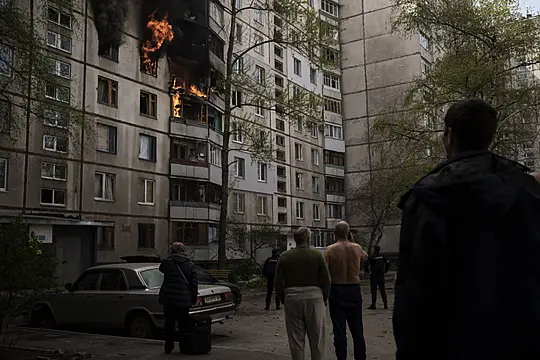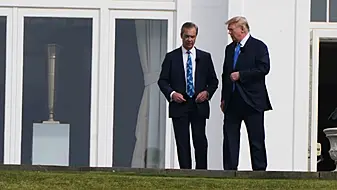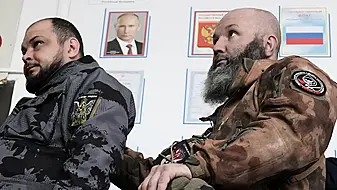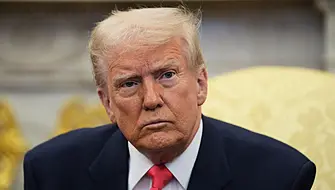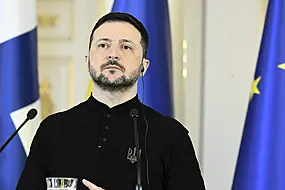Russia has pounded eastern and southern Ukraine as the US promised to “keep moving heaven and earth” to get Kyiv the weapons it needs to repel the new offensive, despite Moscow’s warnings that such support could trigger a wider war.
For the second day in a row, mysterious explosions rocked the separatist region of Trans-Dniester in neighbouring Moldova, knocking out two powerful radio antennas close to the Ukrainian border and further heightening fears of a broader conflict erupting across Europe.
No-one claimed responsibility for the attacks.
Russian missile fire also knocked out a strategic rail bridge along a route that links the southern Odesa port region to neighbouring Romania, a Nato member, Ukrainian authorities said.

The attack on the bridge – along with a series of strikes on key rail stations a day earlier – appears to mark a major shift in Russia’s approach.
Up to now, Moscow has spared strategic bridges, perhaps in the hopes of keeping them for its own use in seizing Ukraine.
But now it seems to be trying to thwart Ukraine’s efforts to move troops and supplies.
Southern Ukraine and Moldova have been on edge since a senior Russian military officer said last week that the Kremlin’s goal is to secure not just eastern Ukraine but the entire south, so as to open the way to the Trans-Dniester.
US defence secretary Lloyd Austin said that more help was on the way, as he convened a meeting of officials from around 40 countries at the United States’ Ramstein Air Base in Germany to pledge more weapons.
Germany announced it has cleared the way for delivery of Gepard anti-aircraft guns to Ukraine.

“This gathering reflects the galvanised world,” Mr Austin said in his opening remarks.
He added that he wanted officials to leave the meeting “with a common and transparent understanding of Ukraine’s near-term security requirements because we’re going to keep moving heaven and earth so that we can meet them”.
After unexpectedly fierce resistance by Ukrainian forces thwarted Russia’s attempt to take Ukraine’s capital early in the war, Moscow now says its focus is the Donbas, the mostly Russian-speaking industrial region in eastern Ukraine.
That move is already having a devastating effect on civilians trapped in the conflict.
In the small city of Toretsk, residents are struggling to survive, collecting rainwater for cleaning and washing up and fervently hoping for an end to the fighting.
“It’s bad. Very bad. Hopeless,” said Andriy Cheromushkin.
“You feel so helpless that you don’t know what you should do or shouldn’t do. Because if you want to do something, you need some money; and there is no money now.”
With the potentially pivotal battle for the Donbas under way, the US and its Nato allies are scrambling to get artillery and other heavy weaponry to that area in time to make a difference.

German defence minister Christine Lambrecht said her government decided on Monday to clear the delivery of Gepard self-propelled armoured anti-aircraft guns to Ukraine, though she did not give details.
German Chancellor Olaf Scholz has faced mounting pressure, including from within his governing coalition, to approve sending heavy weapons such as tanks and other armoured vehicles to Ukraine.
Mr Austin also noted on Tuesday that more than 30 allies and partners have joined the US in sending security assistance to Ukraine and more than five billion dollars worth of equipment has been committed.
A senior Kremlin official, Nikolai Patrushev, warned that “the policies of the West and the Kyiv regime controlled by it would only be the break-up of Ukraine into several states”.
The meeting in Germany comes after Russian foreign minister Sergei Lavrov, speaking on Russian television, warned weapons supplied by western countries “will be a legitimate target”, and accused Nato of “pouring oil on the fire” with its support for Ukraine, according to a transcript on the Russian Foreign Ministry’s website.
Mr Lavrov also warned against provoking a third world war and said the threat of a nuclear conflict “should not be underestimated”.
Russian President Vladimir Putin has cited Nato’s expansion and the risk that Kyiv could join the alliance as reasons for his invasion.
UK armed forces minister James Heappey rejected Mr Lavrov’s accusations of Nato aggression as “utter nonsense”.
He said “the reason there is a war in Ukraine right now is because Russia rolled over the borders of a sovereign country and started to invade their territory”.

Mr Heappey also said Russia was making “unsound” military decisions and giving away tactical advantages because of Mr Putin’s desire to secure some kind of victory by May 9, when Russia marks its victory in the Second World War.
Amid the talk of arms shipments, diplomatic efforts to seek an end to the fighting also continued.
United Nations secretary-general Antonio Guterres met Mr Lavrov on Tuesday and called again for a ceasefire.
The UN chief is scheduled to meet Mr Putin later.
Russia’s invasion has worried several countries in eastern Europe that fear they could be next.
Those concerns grew in Moldova after a Russian commander said that securing southern Ukraine would open the way to the Moldovan separatist region of Trans-Dniester.
On Tuesday, police said explosions knocked down two powerful radio antennas at a facility close to the Ukrainian border, the second explosions reported in the region in as many days.

Washington has warned previously that Russian forces could launch “false-flag” operations to create a pretext for invading the territory of other nations.
Russian officials have rejected such claims.
Ukraine hinted that the attacks there were carried out by Russia. Separatist authorities in Trans-Dniester blamed Ukraine for the explosions.
Elsewhere, International Atomic Energy Agency director General Rafael Mariano Grossi visited the Chernobyl nuclear plant to deliver equipment, conduct radiological assessments and restore safeguards monitoring systems after tanks and troops churned up highly contaminated soil there in the early hours of Russia’s invasion in February.
His visit comes on the anniversary of the disaster at the plant in 1986, the world’s worst nuclear accident.
In its latest assessment of the fighting, the British Ministry of Defence reported Russian advances and heavy fighting in the Donbas region, with one town, Kreminna, reportedly falling after days of street-to-street fighting.
In Mariupol, the besieged city seen as crucial to the fight for the east, authorities said on Tuesday that Russian forces hit the Azovstal steel plant with 35 air strikes over the past 24 hours.
The plant is the last known redoubt of Ukrainian fighters in the city, and some of the civilians sheltering there were wounded in the strikes, officials said.

“Russia has drastically intensified strikes over the past 24 hours and is using heavy bunker bombs,” Petro Andryushchenko, adviser to Mariupol’s mayor, told the Associated Press by phone.
“The number of those wounded will be clear once the rubble is cleared.”
He also accused Russian forces of shelling a route it had offered as an escape corridor from the steel mill and its warren of tunnels and bunkers.
Beyond Mariupol, local officials said at least nine people have been killed and several more wounded by Russian attacks on towns and cities in eastern and southern Ukraine.
Pavlo Kyrylenko, governor of the Donetsk region, said on the Telegram messaging app that Russian forces “continue to deliberately fire at civilians and to destroy critical infrastructure”.
Ukraine’s General Staff said Russian forces shelled Kharkiv, the country’s second-largest city that lies outside the Donbas but has seen significant attacks as Moscow seeks full control of the region.

Ukrainian forces struck back in the Kherson region in the south.
A senior Russian military official has said that Russia’s goal is full control of Ukraine’s east and south, which would give it a swathe of land that lies between Russia and Crimea, which Moscow seized in 2014.
Four people died and nine more were wounded on Monday in the Russian shelling of the Donetsk region of the Donbas, its governor Pavlo Kyrylenko said on Telegram.
He said a nine-year-old girl and a 14-year-old boy were among those killed.
The city council and mayor of Mariupol said a new mass grave was identified about 10 kilometres (six miles) north of the port city, which is key to the battle of the Donbas.
Mayor Vadym Boychenko said authorities were trying to estimate the number of victims.
It was at least the third new mass grave discovered in Russian-controlled areas near Mariupol in the last week.
Mariupol has been gutted by bombardment and fierce street fighting over the past two months.

Russia’s capture of the city, where an estimated 2,000 Ukrainian troops and some 1,000 civilians are reportedly sheltering in a sprawling steel works, would deprive Ukraine of a vital port, help complete the land corridor to Crimea and free up troops to redeploy elsewhere in the Donbas.
Britain said it believes 15,000 Russian troops have been killed in Ukraine since Russia’s invasion began – far above the 1,351 deaths acknowledged by Moscow.
Defence Secretary Ben Wallace said 25% of the Russian combat units sent to Ukraine “have been rendered not combat effective”.
Ukrainian officials have said about 2,500 to 3,000 Ukrainian troops had been killed as of mid-April.
The West hopes that boosting arms supplies will help remaining fighters repel Russia’s invasion.
As he opened the meeting in Germany, Mr Austin sought to reassure Kyiv, saying: “We know, and you should know, that all of us have your back and that’s why we’re here today – to strengthen the arsenal of Ukrainian democracy.”
